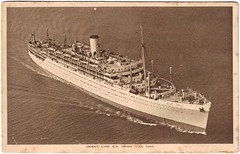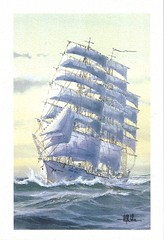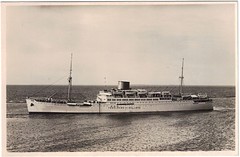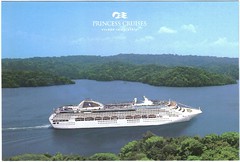23,300 GRT, and 203m in length.
A postcard from Grant in South Australia.
Built as RMS Orion by Vickers Armstrong in 1934, she was the first single-funnelled ship to be built for the Orient Line since the turn of the century. She was also the first ship to be painted in the Orient Line’s corn-colored livery, sporting a pale yellow hull.
She was the first British ship to ever have air-conditioning. In fact her entire interior design was ground-breaking in that she departed from the formal english styles found in wealthy British homes of the time, and adapted a more open-air and spacious layout that was better suited to tropical cruising. Wide promenade decks, slideing glass doors, removable walls, and chromium / bakelite fittings made her feel roomier and breezier, which was a welcome relief in the hot ahd humid tropics.
She was launched by the Duke of Gloucester. But, unusually, he was in Brisbane at the time, and the ship was in Lancashire, UK. He launched the ship by pressing a button in Brisbane, which transmitted a radio signal to the dockyards untimatley causing the ship to slide down the slipway into the water – quite revolutionary for the 1930’s.
She served as a troopship during the second world war, and was involved in a damaging collision with Battleship HMS Revenge when Revenge’s steering gear jammed.
She had an extensive fit-out after the WW2, and voyaged to Australia and the USA.
The National Archives of Australia record that she brought many immigrants to Australia during the late 1940’s, and the 1950’s, eventually being broken up fopr scrap in 1963.
What a fascinating history.







